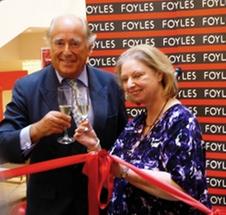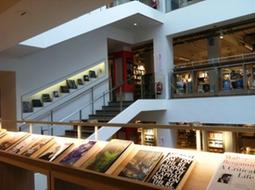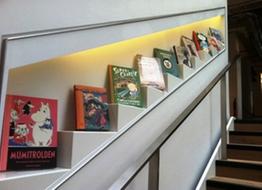
|
|
| Christopher Foyle and Hilary Mantel | |
"If God had been a bookseller, he could have done no better than welcoming you to this temple of words," Hilary Mantel (now Dame Hilary) told the crowd gathered at Foyles bookshop in London last Friday evening. The novelist did the honors during the ribbon-cutting ceremony, the official opening of the new flagship store at 107 Charing Cross Road.
Book lovers packed into the light-filled atrium, lined the staircases on either side and peered down from glass balconies on the floors above as Mantel and owner Christopher Foyle formally introduced the new space--billed as the bookshop for the 21st century--with a champagne toast.
Foyles has had a presence on Charing Cross Road since 1906, with the last 85 years spent in a locale several doors down from the new flagship. The previous store was spread out on five floors over several buildings and had become inefficient and uneconomical to manage, explained Foyle during the grand opening celebration. He joked that customers sometimes became lost in the warren of aisles and had to be rescued by police dogs. .jpg) The revamped Foyles is in a building that previously housed the Central Saint Martins College of Arts and Design. Although the interior has been completely renovated, some notable features from the structure's art school days remain, such as high ceilings and abundant windows that give the store a bright, airy feel.
The revamped Foyles is in a building that previously housed the Central Saint Martins College of Arts and Design. Although the interior has been completely renovated, some notable features from the structure's art school days remain, such as high ceilings and abundant windows that give the store a bright, airy feel.
While the amount of retail space (37,000 square feet) and number of different titles stocked (200,000) is comparable to that of the previous store, the look is dramatically different. When searching for inspiration for the store's esthetic, Sion Hamilton, retail operations director, thought of places like the Tate Modern and the Chicago Institute of Art.
"Galleries are places where there is a lot of information being absorbed, there's a lot of looking," he said. "It's not unlike a bookshop, but often there is more energy. I hope and I think we've created that feel here because if it's an interesting visual space and it's pleasant to shop in and you find new things, then you'll come back."
Encompassing eight levels, the layout flows around the atrium and incorporates multiple mezzanines as well as a 200-seat auditorium, a gallery and a café. In a nod to the building's former occupants, art books have prime space near the store's entrance, while fiction is located on a mezzanine adjacent to the ground floor. Each floor has a different feel, including the science and history section, which is more evocative of a traditional bookstore and a quiet zone for customers seeking solitude.  The many custom details include long, lectern-style display spaces with spot lighting that draws the eye to the books set on them. Another unusual feature is the oversize, vintage-looking murals, near the elevator banks, which commemorate moments in the history of Foyles, such as a literary luncheon series that launched in 1930 and hosted famed guests (John Lennon among them) and the war years, when the store remained open for business.
The many custom details include long, lectern-style display spaces with spot lighting that draws the eye to the books set on them. Another unusual feature is the oversize, vintage-looking murals, near the elevator banks, which commemorate moments in the history of Foyles, such as a literary luncheon series that launched in 1930 and hosted famed guests (John Lennon among them) and the war years, when the store remained open for business.
Some of the flagship's features are the result of suggestions made during workshops Foyles held in early 2013, when customers and book industry representatives were invited to contribute to the design. An idea that resulted from a brainstorming session is a search function that allows customers easily to find a particular book. After accessing the store's wi-fi and searching for the title, they're shown on a map where in the store it can be found and how to get there. 
Ultimately, the beautifully designed and curated bookshop is "a place where discovery is possible," said Hamilton. "We always say that discovery is something that happens to the customer, you can't force it on them, but we've tried to create a space that people want to come in and explore." --Shannon McKenna Schmidt

